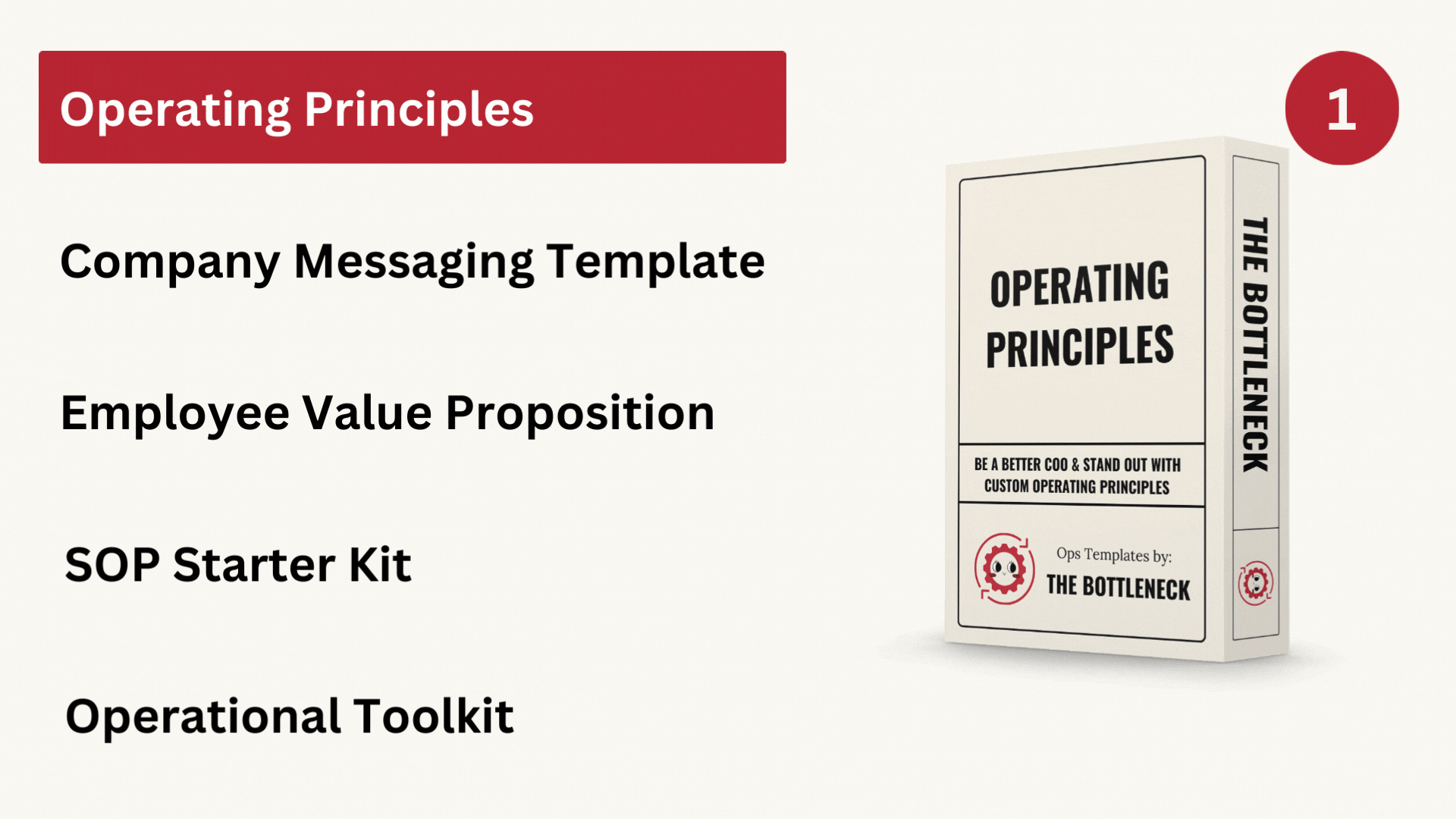
Read Time: 11.4 Minutes
Happy Sunday Operators ⚙️
Cornerstone, the professional COO group we are launching, has some awesome people on the waitlist. While I won’t namedrop (sorry I don’t kiss and tell), here are brief backgrounds:
Series B software COO who has raised over $35 million
COO of an agency acquired for over $50 million
COO of 8-figure design agency
And plenty more. If you want to join the waitlist, just provide your name and Linkedin here.
While building Cornerstone, I gotta remember who the community's most important “nodes” will be. By serving these “nodes”, Cornerstone should grow in time.
Who did I learn this node idea from? Tinder of course!

Together With Monday
The Future of Work Management
Your next project’s BFF. Project management doesn't have to be a headache. monday.com is the friend your projects need. From concept to completion, experience the magic of managing, automating, and streamlining with monday.com.

Setting the Stage
Sorority Girls Hold the Power
Before Tinder, finding love through digital platforms was often a drawn-out experience. Users had to:
fill out long questionnaires
create detailed profiles
sift through many potential matches
before even having the opportunity to connect with someone.
For college students, this was a challenging situation. Juggling busy schedules, limited budgets, and a preference for casual interactions, students found it hard to navigate online dating.
Also, the stigma surrounding online dating was still very much present, particularly among the college crowd. Many students viewed dating sites as reserved for older individuals rather than a tool for young people.
This perception made it difficult for existing platforms like Match.com to gain traction on college campuses. This left a significant gap in the market for a dating app that catered to college kids.
So Tinder tried to solve this problem.
Tinder's goal was to make online dating feel like a game by stripping away the lengthy sign-up process.
The app's emphasis on swiping right to prevent feelings of rejection and its location-based matching system also made it easier for students to connect with people quickly (whether for a quick hookup or a more large relationship).
But this doesn't solve the network problem of getting college users to join the app in the first place.
To solve any marketplace problem, you need to understand the dynamic of the social network you are serving.
Tinder realized by targeting the most interconnected nodes within a network, they could unlock fast growth.
In the context of college campuses, these nodes were sorority girls (duh)!
Greek life is a cornerstone of the American college experience, with sororities and fraternities shaping campus social dynamics.
Sorority girls, in particular, often held a central position within these social networks. These girls wield influence over their peers and set trends that could quickly spread throughout the student body.
By focusing their efforts on this key node, Tinder could tap into the power of social proof and FOMO (fear of missing out) to create a viral effect.
However, sorority girls were often inundated with social invitations and had high standards for the experiences they chose to engage with.
Tinder needed to find a way to cut through the noise and create a compelling value proposition that would resonate.
Ops Tactic: To drive rapid organic growth when building a network, focus on targeting and catering to your market's most sought-after group.

Why this Matters
Get the Right People in for Free Growth
Establishing a strong user base and gaining market traction can make all the difference between success and failure.
Focusing on the most sought-after group within your target market can help drive this. By prioritizing these influential nodes, you can unlock a powerful growth engine that will propel your business forward.
Here's why you should care about this strategy:
Accelerated user acquisition: When you onboard the most influential members of your target market, you tap into their extensive social networks. These individuals have the power to influence the behavior of their peers
Increased user engagement and retention: By catering to their needs, you can foster a sense of loyalty and enthusiasm that keeps them coming back to your platform. This can help to create a vibrant community that attracts and retains other users.
Enhanced social proof and credibility: When the most sought-after members of your target market publicly embrace your product, it sends a powerful signal to others that your startup is worth paying attention to. This social proof can help to establish your credibility, build trust with potential users, and differentiate your startup from competitors.
Reduced customer acquisition costs: Organic, word-of-mouth growth driven by influential nodes can be significantly more cost effective than traditional paid marketing efforts. By focusing on these key individuals, you can minimize your customer acquisition costs
Insights for product development: The most sought-after members of your target market are often the early adopters. Gathering their feedback can provide valuable insights that inform your product development efforts.
As a founder, it's essential to recognize that not all users are created equal. Some individuals wield disproportionate influence within their networks and have the power to shape the opinions of others.
Tinder's success story is a prime example of this tactic's effectiveness.
By focusing on sorority girls, Tinder was able to drive rapid growth.
Take the time to understand the social dynamics within your target market, identify the most influential and sought-after individuals, and craft a strategy that caters to their needs and preferences.

The Blueprint
Here are three powerful tactics to help you build your network by focusing on the right nodes:
I. Figure out the most influential groups AKA nodes
For Tinder, only one group of people mattered: the college sorority girls who used Tinder.
Another company that famously chose the right node to go after was Uber.
As Uber acquired riders, Uber attracted more drivers. This made the service better. Which made rider acquisition to the platform easier.
This virtuous cycle worked because Uber understood that only one group of people mattered in this equation: The riders.
Whoever your central nodes are, you need to keep them engaged with your service. The more central nodes you have, the stronger your network will be due to overlapping connections.
You'll speed up growth while simultaneously strengthening your customer base.
Have those conversations with people on the ground. Map out where the money flows. And understand who holds the power in a social graph.
So who is your priority group?
II. Develop an exclusive, invite-only launch strategy
Try partnering with influential organizations, clubs, or events that cater to your target demographic. For example, Tinder partnered with Greek Life to host exclusive parties where entry was granted only to those who had downloaded the app.
Furthermore, the college campuses where the launch took place were in dense urban areas—which helped spread the user base faster.
In an interview with Bloomberg, Tinder’s technical co-founder Joe Munoz explained:
(Whitney Wolfe) would go to chapters of her sorority, do her presentation, and have all the girls at the meetings install the app. Then she’d go to the corresponding brother fraternity — they’d open the app and see all these cute girls they knew.
Tinder started off with less than 5,000 users before Whitney Wolfe made her trip, and had around 15,000 by the time she returned.
By aligning yourself with these influential groups and providing unique, tailored experiences, you can quickly build buzz and drive adoption among your target market's most interconnected members.
III. Implement referral programs and incentives to fuel word-of-mouth growth
To boost their domination of the college population, Tinder hired “college campus reps” to help promote the app to their peers. They did so by organizing college parties, with some specific entry requirements.
Some make it compulsory for guests to download the app before entering, while others require guests to find a date on Tinder, and bring them to the party. These guidelines help the company ensure their product gets the maximum exposure and downloads.
For people who weren’t cool enough to be invited to the party, this meant that the person you had a crush on was on a ‘dating’ app looking for dates, and you could be on it too.
For anyone downloading the app for the first time, it was already seeded with the most attractive, popular people in your network, creating a beautiful initial experience
For anyone nervous about online dating, it instilled a massive fear of missing out — after all, the person you were interested was probably on Tinder talking to other people.
To further incentivize sharing and engagement, consider creating user-generated content campaigns or challenges that encourage your influential nodes to create and share content related to your product or service.
With the right strategy and execution, you can unlock the power of network effects and watch your user base soar.

Explore Further

Morning Brew College Program
The former CEO of Morning Brew explains in this twitter thread how he grew the companies college program to drive organic growth and ad sales.

How Snapchat Grew
Snapchat stumbled upon its node of Gen Z users to grow its business. Sometimes, there isn’t a master plan when building products.

Real Life Example of a College Ambassador
You always hear from a business person point of view about college programs. Here is the flip side. I recommend reading this to understand what college students priortize.

Spread The Word
Share The Bottleneck with friends to get a few freebies. Maybe you’ll make some new ones on the way 😆
We’ll give you free stuff and more friends if you share a link. Only one link.

{{rp_personalized_text}}

